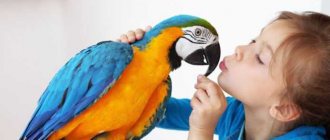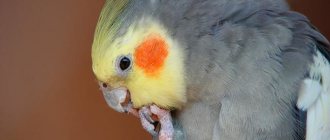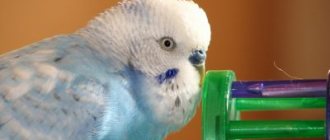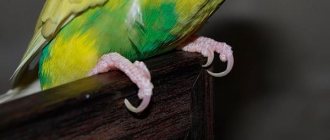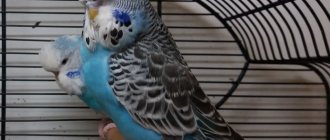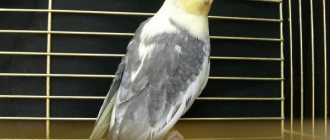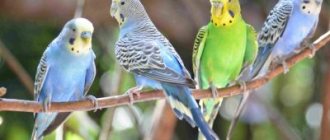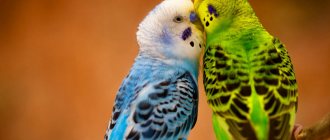How can you teach a parrot to talk?
Nowadays there is such a wide variety when choosing a pet; if previously you could only have a cat or a dog, now, when people have practically forgotten what a communal apartment is, you can even have a crocodile as a friend, as long as you can afford to keep it documentation. Now we’re not going to talk about crocodiles at all, and no important paperwork is required to keep parrots. Of course, unless you have some very rare subspecies.
Photo from the site www.citywoman.info
Indeed, parrots, especially budgies, are now quite popular; many people like the friendly chirping of these babies, moreover, they are very easy to tame and truly become attached to their owner. By the way, just like some cats and dogs, birds feel the approach of their loved one, begin to worry and show their anticipation in every possible way. Agree, it’s very nice to know that a faithful feathered friend is waiting for you at home!
Imagine that this creature can also talk; there are cases when birds can even carry on conversations, because they understand at what moment they need to say what phrase. Cats and dogs, unfortunately, despite the owner’s best wishes, cannot learn to pronounce human words, much less phrases, even though they understand human intonations, but a wavy friend or, especially a larger bird, can be taught to chat. Besides, it is sometimes very interesting and exciting!
How to teach a budgie to talk?
The budgerigar is the most popular of the pet parrots. As noted, only a tame bird can be taught to talk - and a budgerigar is no exception. A bird that is used to you will listen to everything you tell it much more attentively.
Do budgies talk?
Among parrots, the budgerigar is not as talented as, for example, the talking one. However, you can teach him to talk. With constant and patient training, the budgerigar speaks no worse than its imitating relatives.
These parrots are able to remember about 600 words and individual phrases. The budgerigar easily says the names of its owners and its own name, it learns to say greetings or make a request. However, the budgerigar not only talks: he also really likes to sing songs, and some of them like to recite poetry.
Among the budgerigars, the most capable one will be the one that was born weak, and for which it was necessary to take additional care, feeding it and warming it. Such a budgie speaks and learns learning much easier and faster than its healthy brothers and sisters.
Having this bird at home, watch your speech, as sometimes you don’t need to teach your budgerigar to speak at all: there are times when he remembers words and phrases without any effort, having heard them just once.
Do female budgies talk?
It is quite possible to teach a female budgerigar, just like a male, to speak. With active training at a young age, any parrot can become a speaker.
When do budgies start talking?
As a rule, a budgerigar speaks its first word two or three months after the start of training.
How to teach a budgie to talk?
As noted, it is much easier to teach a young budgie (or any other parrot in general) to talk than an adult. Therefore, the best age to start training a parrot is 35 days, when it first leaves its nest.
Before you start teaching your budgie to speak, prepare a separate room for training with your pet, in which it will not be distracted by any extraneous sounds.
You need to work with your parrot every day, at the same time, but only for 5-10 minutes, no more. Make sure that your pet is not overtired, otherwise he will not talk to you.
Also make sure that during classes the parrot listens to you focused and attentively. If you notice that he is distracted, stop the activity. It is possible that at the moment your pet wants to do something else.
You need to constantly practice with a talking parrot, otherwise he will forget what he has already learned. The most difficulties will be with learning the first word, then memorization will become easier.
In the first lessons, to make it easier for your student to understand you, speak to him in his language. What does it mean? Imitate the singing of birds: pronounce all vowels very drawn out, place a strong emphasis on the stress of words, pronounce consonants clearly, especially flaunt the letter “P” - it should sound booming and juicy. Your parrot must understand that human speech is a very interesting and original song.
It will be very easy for your parrot to learn individual sounds. And this will help you understand which sounds are easy for him, and which ones are more difficult for him to cope with. Parrots love playing with sounds, so this kind of training is pure pleasure for them!
Don't start right away with difficult words or long phrases! Start with the simplest words. Try to remember with what intonation you pronounce this or that word, and try not to change this intonation at least at the very beginning of training - wait until your parrot repeats at least one word with confidence. If you suddenly change the intonation that your parrot has just begun to master, you will confuse him and confuse the bird - thereby slowing down the learning process. Move on to the next word only when the parrot has memorized the previous one well.
Your speech should be very emotional, and your articulation should be impeccable. Be sure to change your voice intonation! In order for your parrot to learn to pronounce words clearly, you yourself must pronounce them in front of him with exaggerated clarity, since parrots copy not just a word, but every sound of it with amazing accuracy.
To make it easier for your parrot to remember words, try to pronounce them appropriately. For example, when you come home, say “Hello!” or “Hello!” The parrot will remember words and short phrases better when in contact with you. But in memorizing long sentences or texts, using a tape recorder will help him more.
After finishing the lesson, if your parrot correctly pronounced the word or sang the tune given to him, reward him with some kind of treat.
A parrot needs affection all the time, and not just during classes - since a budgerigar (and any other) parrot can be taught to talk only if there is emotional contact between the bird and the person. And the number of words and phrases that your pet will remember will depend solely on how much effort, time and patience you devote to training the bird.
How to teach a parrot to talk?
Almost everyone who buys a parrot definitely wants to teach it to talk, because in fact, a talking miracle made of feathers will cause a feeling of tenderness and surprise in almost everyone. Where do you start when your parrot starts talking and how do you get him to say exactly the phrases you want?
First, let's discuss which breeds of parrots are most capable of reproducing the sounds of human speech. Remember which birds are most often depicted on the shoulders of stern sea pirates? What birds say “Yo-ho-ho and a bottle of rum!”? Visually, everyone imagined a huge bird, right? Indeed, pirate speech is copied in all films and cartoons not by gentle and cute wavy babies, but by proud and huge Grays.
Photo from the site www.strausof.net
Such a bird can copy the voice of its owner almost perfectly, along with intonation and other features; they reproduce sounds most accurately, and besides, they are really very smart. You may not even be able to distinguish the voice of a bird from the voice of its owner, unless, of course, you see with your own eyes who is talking to you. However, there is one important point: if you have not yet purchased a bird, it is better to buy it secondhand from breeders; those sold in a store or market most often have much less talent for speaking, these are the so-called “wild birds”.
Important
Prefer a bird from a breeder; it will speak faster than a bird bought at the market.
Of course, no other subspecies can compare with the Gray in the art of speaking, but nevertheless, other breeds can also teach their speech, special words or phrases, for example, Amazons and cockatiels can also chat well with a person, but their voice is still not so similar to ours. Huge birds like macaws and cockatoos also perfectly imitate speech, but who doesn’t know about them?
Photo from the site www.strausof.net
All of these parrots are quite large and difficult to care for - some more, some less, but nevertheless, keeping them in a high-rise apartment is more problematic than small budgies, they are, of course, less capable talkers, but they are still can affably entertain you with chirps and chatter.
Rules for teaching parrots to talk
- Zucchini pancakes with minced meat
- How to treat osteoporosis
- Blisters on fingers
The process of teaching a parrot to speak is long and laborious. It requires patience from the person who has taken on the role of teacher. According to ornithologists, parrots perceive the speech of women and children better, so the owner of the pet is preferable as a teacher. One person should handle the bird. In addition, the following rules should be taken into account:
- Classes are conducted in complete silence, as parrots are naturally terribly curious. If the silence regime is not observed, the “student” will become distracted and will not remember the required combination of sounds. Particular attention should be paid to the TV. The sounds coming from it will not allow the bird to concentrate.
- Teaching words should be accompanied by corresponding action. When learning the word “hello”, you should enter the room, and “bye” is said if you leave the room.
- Classes should be scheduled at the same time. The duration of the lesson should be 15-20 minutes. In addition, once a week it is recommended to conduct a long strengthening lesson for 40-45 minutes.
- The first word to learn must have two syllables.
- To facilitate training, the use of a tape recorder or voice recorder is allowed. The recording periodically turns on and off, but during the lesson you must be close to the “student”.
- It is necessary to interest the pet and maintain its curiosity throughout the lesson. Signs such as head movements, wing twitching and blinking indicate interest on the part of the ward.
- You can't yell at the bird and punish it. If the student is not in the mood to study, you should give him a treat that will attract his attention.
- One of the rules of learning is persistence. Even if the “student” does not want to study, it is necessary to attract his attention.
- Young parrots should be taught from the age of 2 months.
How to quickly teach a parrot to talk?
If you are interested in the question of how to teach a parrot to talk in 5 minutes, then the answer is very simple and laconic - nothing. But if you devote at least five minutes a day to this activity, the result will one day please you. It is best to choose a male as the first “student”; they learn faster, but females can also be taught; do not be upset if you already have a feathered beauty in your cage. We can make you happy: the pupil will, of course, take a little longer to understand and understand the course of the matter, but she will begin to pronounce the memorized words much more clearly. How to teach a girl parrot to speak? Not much more difficult than a boy!
Photo from the site xn--80aacenrmb1f7d9a.xn--p1ai
How to teach a parrot to talk
Many parrot owners dream of teaching their bird to speak. A bird trained to speak evokes tenderness and delight in any person who is not deprived of at least a grain of love for these sweetest creatures. So how do you teach a parrot to speak?
Grays are traditionally considered the most talkative parrots, capable of relatively accurately copying human speech. Most parrots of this species are capable of very accurately copying a human voice. They do it so well that you can easily determine whether the “author’s” voice belongs to a woman or a man. But even among Grays, alas, there are parrots that completely lack the talent for conversation and taming - these are usually birds that are sold in stores and markets, i.e. wild, people call them savages.
Many Amazons, cockatiels and other species of parrots can also speak, but, unlike Grays, their “talking” voice is different from that of a human. Excellent imitators are sometimes found among large parrots - cockatoos and macaws. Common budgies, popular in our country, are also capable of conversation, but to a much lesser extent of conversation.
Among some bird lovers who are wondering how to teach a parrot to speak , there is an opinion that females are completely immune to human speech. In fact, everything is not so dramatic: females learn to speak, although they are more difficult than males. However, it is worth noting that females pronounce words more clearly than representatives of the opposite sex.
Large parrots should begin learning to speak at two to three months of age, small parrots from 30 days. Chicks learn more easily than mature parrots, but there are cases when a ten-year-old parrot began to speak.
Any person whom the bird trusts can teach a parrot to speak. It is for this reason that the parrot must be tamed before learning to speak. He should not worry in your presence or be afraid to take food from your hands; a tamed bird should calmly sit on the owner’s shoulder or hand.
You can teach a parrot to speak only when it is calm. The bird should not be distracted by anything (no noise from the TV, no clinking of dishes). Other parrots nearby will also interfere with learning.
A very important aspect when teaching a parrot to talk is systematic training. In order to quickly teach a parrot to speak, you need to practice daily, several times a day. So, for example, one lesson lasting 10-20 minutes can be held in the morning, before feeding, in the afternoon the lesson should last 35-40 minutes, and in the evening - about 20.
You need to start learning with the simplest words. Parrots easily learn the vowel sounds “a” and “o”, the consonants “t”, “r”, “k” and “p”, as well as the hissing sounds “ch” and “sh”. That is why it is preferable to use these particular sounds in the name of the bird. It should also be said that parrots remember the speech of children and women best - it is easier for birds to reproduce voices with a high timbre. As new words are learned, it is necessary to repeat the old ones - otherwise the parrot will simply throw them out of memory.
Let us remember that most birds only imitate human speech, without having any idea about the meaning of words. It is for this reason that parrots say various phrases or words that are completely out of place. If you still want the bird to respond correctly with words to your specific actions, for example, to say “hello” to you upon returning home, then you should develop conditioned reflexes in the parrot. So, when you come home, say “hello” in an even and clear voice, and at the end of this lesson, give him a treat. Over time, the parrot will associate this word with your return.
Owners of talking parrots who do not have enough free time, trying to understand how to teach a parrot to talk, resort to tape recordings. Is it worth doing this? The use of recorded speech instead of live speech is indeed justified in some cases. However, even when using this method, you still need to stay in the same room with the bird. If a parrot gets used to talking alone, then you are unlikely to be able to force it to talk in your presence. In addition, it is better to turn on the recording only when the bird already knows at least a couple of words. We do not encourage this method of teaching, since dialogue with a parrot will never work.
When training, under no circumstances should you shout or insult the parrot, otherwise it will learn the insult and will constantly repeat it. Teach your bird only phrases that are pleasant to your ears, because if she learns to speak, then you will have to listen to her ranting quite often. It is worth mentioning that you will have to live with caution with a parrot that can speak: You will have to watch their speech, because these birds learn some words, especially emotionally charged ones, on their own and quite quickly.
Be aware that teaching a parrot to talk is a long process. The list of words and phrases learned by a bird, depending on its abilities, can include either ten or two hundred or three hundred items, for example the list of words of the talking gray parrot Gregory . Remember that a friendly and attentive attitude towards and care for a parrot are more valuable and important things. Be patient, and your bird will definitely repay you with sincere love and friendship!
At what age do parrots start talking?
This question is really interesting, parrots begin to speak when they learn, but when to start training them and when they are able to perceive speech is a completely different conversation. If you have a bird larger than a budgie, start communicating with it at two or even three months, but babies can attend lessons as early as a month. Remember that the sooner you start training, the faster the results will come. Chicks are faster and easier to train than adults, although it should be mentioned that there have been cases when an already old parrot started a conversation.
Photo from the site lmlnews.ru
Now let's talk directly about the lessons. The bird will not repeat anything after a person who is unpleasant to it or causes fear and apprehension, therefore, after buying a parrot, there is no need to immediately start training, let the baby get used to you and fall in love with you, treat him with goodies, talk to him affectionately, Do not allow sharp and loud sounds and unexpected noises; in general, at first, just do taming. You can start talking directly if you have already become friends and the parrot calmly tolerates your presence nearby, sits on your shoulder and takes treats from your hands.
Now that trust has been created, you need a calm environment, if you played with the bird, or he flew around the apartment for a long time, or at the moment something distracts him and attracts his attention, for example, a talking TV, the sound of pouring water, he will not be able to perceive either you or yours. speech. Be sure to start your lesson in a quiet and calm environment.
Important
Earn your pet’s trust, only after that you can start lessons.
Now information for those who are interested in how to teach a parrot to speak in five minutes. It is very important that lessons are systematic and regular. In order for the bird to speak, it is advisable to chat with it several times a day, not for very long - 10-20 minutes at a time will be enough for the bird to begin to listen to you and remember the sound of speech. In the morning, before pouring food into the feeder, chat with your pet for 1-15 minutes; in the evening, when you come home from work, also pay attention to the bird, maybe a little longer - 20 minutes.
It is imperative to give words that the bird is able to remember; you can complicate phrases as you go, but you can start with the simplest. Birds are best at words that contain hissing letters; they pronounce the letter “r” well, as well as the melodious vowels “a” and “o”, keep this in mind when starting classes and choosing a name for a friend.
Photo from the site www.popugai2.ru
Parrots perceive melodious female speech and the sonorous voices of children best, so it will be easier for a girl and boys to teach a pet to chat than for the head of a family. A prerequisite for a wide range of words is repetition. Yes, the rule “repetition is the mother of learning” works even here, if you once heard Kesha say his name, start teaching him to say “hello” and completely forget about the first word he learned, he will simply forget it.
How to teach a budgie to speak?
Dialogue with a parrot
Feed by hand
Frozen
A pet
There is an opinion that only male budgerigars can talk. However, this is absolutely not true, because with proper training, a budgie of any gender can be taught to speak. Females also have the ability to reproduce heard sounds, and they reproduce words more clearly than males, although more effort and time have to be spent on training them.
The main condition for quickly teaching a budgie to speak is the timely start of training, according to the principle: the earlier, the better. Therefore, teaching spoken language to budgies should begin as soon as they become stronger, are able to feed themselves and begin to perceive the sounds around them. Usually this is the age starting from two months, preferably no later than four months. The older the parrot, the more difficult it is to learn, although there have been cases where parrots mastered speech even at the age of several years.
In order for a parrot to be trainable, it must trust the person who works with it in everything. Therefore, training as such begins with its taming. First you need to tame the chick not to be afraid of human hands. The first exercises are hand feeding and sitting on the palm or shoulder. These actions must be carried out very carefully and slowly. No sudden movements, so that the bird does not get scared, but rather gets used to it and begins to feel absolutely calm in these situations.
When feeding time comes, there should be no one in the room except you and the bird. Food should be given little by little to find out what the chick likes best. When serving food, you need to pour a little on the saucer, and leave the rest in your hand, so that after pecking a few grains from the saucer, he pecks the rest from your hand. In this case, in a quiet, calm voice, you need to say monosyllabic words like: ko-ko or yum-yum several times. With the right actions, within a few days he will calmly sit on your hand. Classes should be carried out at least three times a day, at the same time. Within a week, ten days, the hungry bird will repeat ko-ko or yum-yum.
Always remember that the parrot will be receptive to your words only when there is nothing to distract it: conversations, the clink of dishes, the sound of the TV, and even the presence of its fellows nearby.
When the parrot gets used to you a little, it is worth complicating the task by pronouncing more complex and longer single or paired words. But in any case, they should consist of sounds more familiar to the usual exclamations of a parrot. This could be: eat, drink, want to eat, give me water, etc. It may take another week to master these words. But when you appear, you can hear these memorized words from your pet.
From this time, the main training period begins, during which you can teach your budgerigar to speak, with increasing complexity, those words, phrases and whole sentences that you want your parrot to say. An important point when training a parrot is systematic training. In order for him to speak quickly, you need to work with him several times a day every day. For example, 10-15 minutes in the morning before feeding, 20-30 minutes in the afternoon, and 20-30 minutes in the evening.
To prevent your pet from talking only to you, you need to involve all family members in the training so that they periodically engage with the bird. Don't try to use electronic recordings that repeat phrases. The parrot will quickly get bored with this, and he may lose interest in activities. Then it will be very difficult to return his interest in learning. In addition, budgerigars are very susceptible to sociability with a living person, this creates a special mood for them and allows them to quickly learn new sounds and the ability to conduct a conversation in the form of dialogue.
Keep in mind that budgies perceive the voices of women and children better, and it is easier for them to reproduce high-pitched sounds. When teaching your pet new phrases, do not forget to repeat the old ones. Otherwise, they will simply be erased from the bird’s memory.
Depending on individual abilities, budgies can learn to speak from a dozen to a hundred different words. Although in order to teach a budgerigar to speak, you will have to work hard for more than one month. And for your parrot to be a good conversationalist, and not just repeat phrases like “You’re a fool” or something else like that, you need to talk to him constantly and not let it happen.
You should control your speech in the presence of a parrot. Because often he quickly remembers words or phrases he heard not during training, but just like that, from the outside. So, he can easily remember an emotionally obscene word or an obscene joke said in front of a parrot and tell it to younger family members or guests at the wrong moment. You can meet one such feathered swearer here: The Talking Parrot.
Be patient, kind and attentive to your feathered pet and you can be sure that he will definitely repay you with his affection, love and loyalty.
Interesting Facts
At the beginning of the article it was said that birds can even carry on conversations, but we embellished the reality a little - in fact, parrots reproduce, imitate your speech or some sounds, so in order for your Keshka to learn to say words on the spot and thereby entertain you and your guests will have to work a little extra. In fact, there is nothing difficult about this, you just need to do a little training.
Photo from the site www.popugai2.ru
For example, you want your friend to greet you from work with the word “hello,” so when you open the apartment door, say “hello” very clearly, loudly and clearly, every time, and after that give your baby a treat. After several lessons, the bird will remember that the treat is associated with the word hello and your return home.
